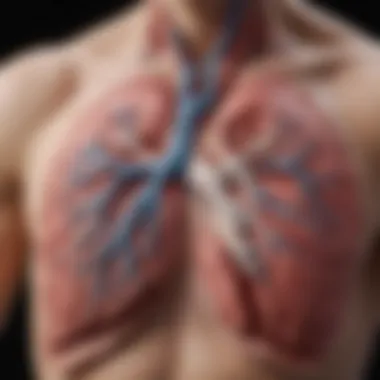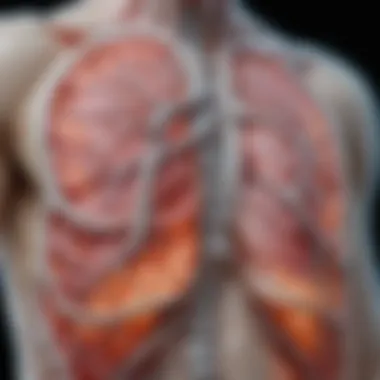Middle Lobe Lung Cancer: A Comprehensive Overview


Intro
Middle lobe lung cancer, while regarded as a less common form of lung cancer, presents unique challenges that merit thorough examination. This specific subtype is notable for its anatomical position and clinical implications. Understanding its etiology, progression, and individual patient response is crucial for effective management and treatment.
In this article, we will navigate through the complexities surrounding middle lobe lung cancer. We will analyze recent advancements in research, established methodologies, and patient care strategies. By diving deep into these areas, the aim is to provide an informative resource for students, researchers, educators, and professionals who seek to enhance their understanding of this condition.
Recent Advances
Latest Discoveries
Recent studies have unveiled significant patterns in the genetic mutations associated with middle lobe lung cancer. Key mutations such as those in the EGFR and KRAS genes have been linked to patient prognosis and response to treatments. Furthermore, ongoing research emphasizes the role of environmental factors and individual lifestyle choices, establishing a more nuanced view of causative factors.
Technological Innovations
Advancements in imaging techniques have greatly improved diagnosis accuracy. Positron Emission Tomography (PET) and advanced CT scans provide enhanced visualization of the lungs, aiding in early detection. Moreover, artificial intelligence is revolutionizing pathology by streamlining the identification of malignant cells in tissue samples, thus ensuring timely intervention.
Methodology
Research Design
To fully grasp the nuances of middle lobe lung cancer, a multifaceted research design is necessary. Cross-sectional studies, along with longitudinal analyses, allow for the evaluation of factors such as patient demographics, treatment outcomes, and survival rates. This blend of qualitative and quantitative approaches provides a holistic view of the disease.
Data Collection Techniques
Data collection for understanding middle lobe lung cancer typically involves several techniques. Surveys and patient interviews offer firsthand insights into symptoms and treatment effects. Additionally, medical records provide invaluable quantitative data regarding treatment regimens, recurrence rates, and long-term outcomes.
Intro to Middle Lobe Lung Cancer
Middle lobe lung cancer is a subset of lung cancer that specifically affects the middle lobe of the right lung. This region is notable for its unique anatomical positioning and specific challenges it poses in terms of diagnosis and treatment. Understanding this specific cancer type can significantly influence patient outcomes, making it essential for healthcare professionals and researchers alike. This section will illuminate the fundamental aspects and importance of middle lobe lung cancer in the broader context of oncology.
The uniqueness of middle lobe lung cancer lies in its characteristic presentation and symptoms, as well as its relationship to smoking and other risk factors. As part of a comprehensive overview, this article seeks to shed light on various facets, including etiology, diagnostics, and emerging therapies. This foundation can help clinicians tailor their approaches to diagnosis and treatment, enhancing patient care.
Key considerations include:
- Anatomical specificity: The middle lobe's location can affect the spread of cancer and the effectiveness of treatments.
- Incidence awareness: Knowledge of how common this type is among lung cancers can aid in early detection and appropriate screening.
- Clinical implications: Understanding the unique signs and symptoms can assist healthcare providers in delivering accurate diagnoses and treatment plans.
As the article progresses, the following sections will build on this foundation, providing further insights into the complexities of middle lobe lung cancer, its epidemiology, and potential therapeutic strategies.
Epidemiology
Understanding the epidemiology of middle lobe lung cancer is critical to grasping its impact on public health and clinical outcomes. Epidemiology examines the distribution and determinants of health-related states or events. In the context of lung cancer, including its middle lobe variant, it provides insight into how often these cases occur, in whom, and the risk factors involved. Knowing the epidemiology can lead to more effective prevention strategies, early detection programs, and tailored treatments.
Incidence and Prevalence
The incidence of middle lobe lung cancer is relatively low compared to other lung cancer types, but it still poses serious health risks. Studies show that lung cancer is the leading cause of cancer deaths globally, and specific statistics on middle lobe cancers can highlight its significance. Despite the overall decline in lung cancer rates in several regions, certain populations still exhibit elevated incidences.
According to recent data, the incidence of lung cancer in the general populace is around 60 per 100,000 individuals annually. Middle lobe tumors, however, account for a minor percentage of these figures, often reflecting a unique presentation and may require specific diagnostic criteria.
Demographic Factors
Demographic factors play a vital role in understanding who is most at risk. Age, gender, race, and geographic location are key components to consider. Middle lobe lung cancer tends to present more frequently in older adults, usually over the age of 60. Gender differences also exist, with males showing higher rates, possibly due to historical tobacco smoking prevalence.
Geographic variances show that urban populations may have higher incidences due to environmental exposures. Additionally, racial disparities in lung cancer statistics have been documented, indicating that certain ethnic groups may be disproportionately affected.
Overall, a comprehensive understanding of these factors assists healthcare professionals in identifying at-risk groups and developing targeted intervention strategies.
Pathophysiology
Understanding the pathophysiology of middle lobe lung cancer is crucial. It provides insights into how tumors form, grow, and spread within lung tissue. By examining these mechanisms, researchers and clinicians can better tailor interventions and improve treatment outcomes. As a subtype of lung cancer, the middle lobe presents unique challenges that require distinct approaches. Grasping the underlying pathological processes informs not only early detection but also the design of treatment plans.
Origins of Tumor Development
Middle lobe lung cancer typically originates from the epithelial cells of the bronchial tissue. These cells can undergo malignant transformation due to several factors. The initial phase often involves genetic damage, which can result from a variety of environmental and lifestyle influences.
The tumorigenesis process is multifactorial:
- Exposure to Carcinogens: Tobacco smoke contains numerous carcinogenic compounds that can lead to cellular mutations.
- Chronic Inflammation: Conditions like chronic bronchitis can create a microenvironment conducive to tumor development.
- Genetic Susceptibility: Some individuals may possess hereditary factors that increase their risk for lung cancer.
These factors collectively influence how and when tumors develop in the middle lobe, underscoring the importance of understanding their roles in cancer progression.
Genetic Mutations and Markers
Genetic mutations play a significant role in the pathophysiology of middle lobe lung cancer. Mutations in critical oncogenes and tumor suppressor genes can drive abnormal cell growth and division. Key mutations often observed include alterations in the EGFR gene, KRAS gene, and ALK rearrangements. Each mutation can affect treatment approaches significantly, as specific therapies may target these genetic abnormalities.
Furthermore, certain tumor markers can serve as valuable tools for diagnosis and monitoring.
- EGFR: Mutations in the epidermal growth factor receptor gene can indicate responsiveness to targeted therapies such as erlotinib or gefitinib.
- ALK Rearrangements: This marker suggests eligibility for crizotinib or other ALK inhibitors.
Understanding these genetic aspects aids in the development of personalized medicine strategies, allowing for more effective and targeted treatments for patients diagnosed with middle lobe lung cancer.


Risk Factors
Understanding the risk factors associated with middle lobe lung cancer is crucial for both prevention and detection. Risk factors highlight the elements that may increase an individual's likelihood of developing this specific subtype of lung cancer. By identifying these factors, researchers and medical professionals can target interventions more effectively, and patients can take proactive steps in consultation with their healthcare providers. Moreover, knowledge of these risk elements can enhance awareness among patients and the general public, facilitating early detection and improving patient outcomes.
Environmental Influences
Several environmental exposures can significantly influence the risk of developing middle lobe lung cancer. These may include:
- Air Pollution: Prolonged exposure to polluted air, especially in urban areas, can contribute to lung disease. Particulate matter and other harmful chemicals found in the air can damage lung tissue over time.
- Occupational Hazards: Certain occupations expose individuals to carcinogenic substances such as asbestos, arsenic, and heavy metals. Industries like construction, mining, and chemical production can have higher incidences of lung cancer due to these exposures.
- Secondhand Smoke: Exposure to tobacco smoke from others can be a major risk factor. This involuntary exposure can lead to cellular changes in the lungs, increasing the susceptibility to cancer.
Considering the potential dangers in our environment is vital. Identifying and minimizing exposure to these risks can potentially lower the incidence of lung cancers. Increased public awareness and policies to reduce pollution can play a significant role in prevention.
Lifestyle Choices
Lifestyle factors also contribute heavily to lung cancer risk. Certain habits and choices can either promote health or increase the likelihood of developing the disease. Some significant lifestyle factors include:
- Smoking: The most prevalent risk factor for lung cancer is smoking tobacco. Cigarette and pipe smoking create numerous toxic substances that damage cells in the lungs.
- Diet and Nutrition: Poor dietary habits can lead to deficiencies in essential nutrients like vitamins and antioxidants. A diet rich in fruits and vegetables may help in reducing cancer risk, while a lack of these can weaken the body's defenses against carcinogens.
- Physical Activity: Sedentary lifestyles can lead to various health issues, including obesity. Increased body weight is linked to several types of cancer, including lung cancer.
Making informed lifestyle choices is essential for reducing risk factors. Encouragingly, behavior changes can significantly lower risk. Thus, awareness, education, and community support can empower individuals to combat the threat of middle lobe lung cancer through sensible decisions.
Clinical Presentation
The clinical presentation of middle lobe lung cancer is vital to understand its impact on patient management and outcomes. Recognizing the symptoms and signs can lead to earlier diagnosis, which is crucial since lung cancer often presents late in its course. Knowledge of the clinical features allows for more timely intervention and tailored treatment plans, ultimately affecting the patient's quality of life and survival rates.
Symptoms and Signs
Patients with middle lobe lung cancer may exhibit a variety of signs and symptoms. Understanding these is essential for medical professionals and caregivers. Common symptoms include:
- Persistent cough: A cough that does not go away or worsens over time may be an early indicator of lung cancer.
- Chest pain: Discomfort or pain in the chest area can signify tumor presence or lung involvement.
- Shortness of breath: Difficulty in breathing may arise due to airway obstruction from a tumor.
- Unexplained weight loss: Significant weight loss without trying can be a system-wide signal of malignancy.
- Hemoptysis: Coughing up blood is a more alarming sign that often necessitates immediate investigation.
- Fatigue: Ongoing fatigue that does not improve with rest can indicate an underlying health issue, including cancer.
These signs are not exclusive to lung cancer and may arise from various conditions. Therefore, a thorough evaluation is crucial when patients present with these symptoms.
Differential Diagnosis
Differential diagnosis is an essential step in the clinical evaluation of suspected middle lobe lung cancer. Given the nonspecific nature of many respiratory symptoms, it becomes important to differentiate lung cancer from other conditions such as:
- Pneumonia: This infection can mimic lung cancer symptoms and may lead to misleading treatments.
- Tuberculosis: A chronic infection that presents with similar symptoms, but requires different management.
- Pulmonary embolism: A life-threatening condition caused by blood clots in the lungs can also cause sudden onset of shortness of breath and chest pain.
- Chronic obstructive pulmonary disease (COPD): Patients with a history of smoking may present with cough and breathlessness, complicating the diagnosis.
- Other malignancies: Tumors from other primary sites can also metastasize to the lungs.
The importance of a comprehensive approach including imaging and laboratory tests can not be overstated. These evaluations help establish an accurate diagnosis and inform the treatment strategies moving forward.
"A meticulous clinical evaluation can greatly influence the management strategies for middle lobe lung cancer, potentially improving patient outcomes."
Understanding the clinical presentation of middle lobe lung cancer enhances early detection and facilitates better care pathways.
Diagnostic Approaches
In the realm of middle lobe lung cancer, accurate diagnosis is paramount. This section elucidates the diverse methods employed to identify this particular type of lung cancer, which is notably essential for effective treatment and management. Understanding the diagnostic approaches can aid in early detection, ultimately influencing patient outcomes positively.
Imaging Techniques
Imaging plays a critical role in diagnosing middle lobe lung cancer. Various imaging modalities are utilized, each offering unique advantages and considerations. The common imaging techniques include:
- Chest X-ray:
This is often the initial imaging study performed when lung cancer is suspected. It can reveal masses or abnormalities in the lungs but has limitations in sensitivity, especially for small lesions. - Computed Tomography (CT) Scan:
CT scans provide detailed cross-sectional images of the lungs. They help identify the size and shape of the tumor and can detect enlarged lymph nodes, which are indicators of potential metastasis. It is an essential tool for staging the disease. - Magnetic Resonance Imaging (MRI):
Although not as commonly used for lung cancer detection as CT scans, MRIs can be beneficial in evaluating specific cases where there are concerns about the involvement of the chest wall or mediastinum. - Positron Emission Tomography (PET) Scan:
PET scans are utilized to assess metabolic activity within the tumor. This technique is particularly useful for distinguishing between malignant and benign lesions, which is crucial for treatment decisions.
These imaging techniques collectively contribute to forming a comprehensive picture of the disease. They guide further investigative procedures such as biopsy.
Biopsy and Histopathology
Once imaging identifies a suspicious lesion, biopsy remains the definitive method for diagnosing middle lobe lung cancer. A biopsy enables the collection of tissue samples, which are analyzed histologically to establish the presence of cancerous cells. Here are the key biopsy techniques:
- Bronchoscopy:
This procedure involves a thin tube inserted through the nose or mouth to access the lungs. It allows for direct visualization and sampling of lung tissue, specifically targeting lesions located in the central airways. - Computed Tomography-guided Needle Biopsy:
For lesions that are peripheral or difficult to reach via bronchoscopy, a CT-guided needle biopsy can be employed. The imaging assists in accurately positioning the needle to collect tissue samples from the tumor. - Surgical Biopsy:
In some cases, a surgical biopsy may be necessary, particularly when other methods fail to provide conclusive results. This method entails removing a portion of the lung tissue for examination.
After obtaining the biopsy, histopathological analysis is conducted.
Histopathology assesses the cellular characteristics of the tumor, providing crucial information regarding its type, grade, and potential behavior.
Understanding these diagnostic approaches is vital for clinicians and enhances the overall management of patients. Early diagnosis and accurate characterization of middle lobe lung cancer not only improve treatment strategies but also optimize the quality of life for those affected.
Staging and Prognosis
Staging and prognosis are vital components in the management of middle lobe lung cancer. Understanding the stage of cancer is crucial for developing effective treatment strategies. The staging system used helps oncologists classify the disease based on its extent of spread in the body. This classification informs both the potential treatment options and the expected outcome of the disease, which is the prognosis. A precise staging allows the medical team to tailor therapies specifically to the patient's needs, thereby enhancing the likelihood of successful intervention.
Staging Systems
The staging of lung cancer follows established systems, with the most widely recognized being the TNM system, developed by the American Joint Committee on Cancer. "T" refers to the size and local extent of the tumor, "N" indicates the absence or presence of regional lymph node involvement, and "M" denotes the presence of distant metastasis.
- Tumor (T):
- Nodes (N):
- Metastasis (M):
- T1: Tumor ≤ 3 cm, not involving the main bronchus.
- T2: Tumor > 3 cm or involving the main bronchus but ≤ 5 cm.
- T3: Tumor > 5 cm or involving the pleura or pericardium.
- T4: Tumor of any size with invasion into other organs.
- N0: No regional lymph node metastasis.
- N1: Metastasis to ipsilateral nodes.
- N2: Metastasis to contralateral or additional ipsilateral nodes.
- N3: Metastasis to supraclavicular nodes.


- M0: No distant metastasis.
- M1: Distant metastasis present.
Stages range from Stage I, where the cancer is localized, to Stage IV, where there is extensive spread of cancer. The prognosis varies significantly depending on the stage at diagnosis. Earlier stages often lead to better outcomes due to the availability of more aggressive treatment options.
Factors Influencing Prognosis
Several elements can influence the prognosis of patients with middle lobe lung cancer. These factors include:
- Tumor Size and Location: Larger tumors usually correlate with a poorer prognosis. The location of the tumor in the lung can also affect surgical accessibility and treatment effectiveness.
- Lymph Node Involvement: The presence of cancer in lymph nodes generally signifies a more advanced disease and often indicates a less favorable outcome.
- Molecular and Genetic Markers: Certain genetic mutations, such as EGFR or ALK, can guide treatment decisions and impact prognosis positively if targeted therapies are available.
- Patient Health: Overall health status, comorbidities, and age can significantly influence treatment resilience and recovery.
- Treatment Response: How well a patient responds to initial treatment can serve as a predictive factor for long-term outcomes. Good initial responses usually lead to more favorable prognoses.
Understanding these factors is essential for clinicians to offer realistic expectations and inform treatment planning for their patients.
In summary, staging and prognosis are integral to managing middle lobe lung cancer effectively. Accurate staging contributes to choice of treatment, and a comprehensive understanding of the prognostic factors is essential for patient care.
Treatment Strategies
Treatment strategies for middle lobe lung cancer are essential for establishing an effective management plan. This section outlines the various approaches available to clinicians, focusing on surgical interventions, radiation therapy, and chemotherapy and targeted therapy. The objective is to ensure early diagnosis and tailored treatments based on patient-specific conditions.
Surgical Interventions
Surgical interventions can be a crucial component in treating middle lobe lung cancer, especially when diagnosed at an early stage. The primary goals of surgery include the complete removal of the tumor while preserving lung function whenever possible. Lobectomy, which involves the removal of the affected lobe, is commonly performed. In some cases, a wedge resection is an option, targeting only the tumor and a small margin of healthy tissue.
There are several considerations for surgical candidates. Factors such as the patient's overall health, lung function, and the tumor's stage significantly influence decisions. An important aspect is the timing of the surgery. It is vital to balance the potential benefits of removing the tumor with the risks of surgical complications. Research shows that early-stage patients who undergo surgical resection often experience better outcomes compared to those who don’t.
"Timely surgical intervention can significantly improve survival rates for patients with early-stage lung cancer."
Radiation Therapy
Radiation therapy serves multiple roles in the treatment of middle lobe lung cancer. It can be utilized as a primary treatment in patients who are not surgical candidates, or as an adjuvant treatment following surgery to provide additional control over residual disease. The two primary types of radiation therapy are external beam radiation therapy (EBRT) and stereotactic body radiation therapy (SBRT).
Benefits of Radiation Therapy:
- Non-invasive: Unlike surgery, radiation is non-invasive and can be administered on an outpatient basis.
- Targeted Treatment: Modern techniques allow for precise targeting of the tumor, minimizing damage to surrounding healthy tissue.
- Palliative Care: In advanced cases, radiation therapy can alleviate symptoms caused by tumor growth, such as pain or obstructions.
Radiation therapy does have its drawbacks, including potential side effects like fatigue and localized irritation. Its integration into a treatment plan must be carefully considered based on the individual patient’s situation and overall treatment goals.
Chemotherapy and Targeted Therapy
Chemotherapy and targeted therapy are often essential components of the treatment landscape for middle lobe lung cancer. These approaches may be combined with surgery and/or radiation, particularly in cases of advanced disease.
Chemotherapy generally involves the use of systemic agents that target rapidly dividing cells. Common regimens might include combinations of drugs such as carboplatin and pemetrexed. While effective in many cases, chemotherapy often comes with side effects, such as nausea and fatigue.
Targeted Therapy, on the other hand, focuses on specific genetic mutations involved in cancer growth. Drugs like erlotinib or crizotinib are examples of targeted therapies that may benefit patients whose tumors exhibit specific markers.
Benefits of Chemotherapy and Targeted Therapy:
- Systemic Control: Offers an ability to manage microscopic disease that surgery and radiation alone may not address.
- Improved Outcomes: Specific regimens have shown improved survival rates in patients with certain genetic profiles.
- Personalized Treatment: Advances in molecular testing allow for more personalized treatment plans.
Emerging Therapies
Emerging therapies represent a pivotal segment in the ongoing fight against middle lobe lung cancer. This area of research is crucial as it leads to innovative treatments that can enhance patient outcomes and alleviate the challenges presented by this specific subtype of lung cancer. The advancements in therapeutic strategies showcase the evolving landscape of oncology, focusing increasingly on personalized medicine. These therapies not only aim to improve survival rates but also to offer targeted approaches that can effectively manage the disease with fewer side effects.
Immunotherapy
Immunotherapy has emerged as a significant cornerstone in cancer treatment, harnessing the body’s own immune system to combat tumor cells. For middle lobe lung cancer, the application of immune checkpoint inhibitors has shown promising results. Drugs like pembrolizumab and nivolumab are designed to block proteins that prevent immune responses against cancer. This approach can result in durable responses in some patients, transforming the way lung cancer is treated.
The benefits of immunotherapy include:
- Targeted action: Immunotherapies tend to be more selective, focusing on cancer cells while sparing normal cells.
- Sustained response: Some patients experience long-lasting effects even after treatment has ended.
However, there are considerations:
- Not all patients respond to immunotherapy, and biomarker testing is essential to identify those who may benefit.
- Side effects can include immune-related adverse events, necessitating close monitoring.
Ultimately, immunotherapy represents a transformative possibility for patients with middle lobe lung cancer, indefinitely altering management strategies and therapeutic goals.
Novel Drug Developments
In addition to immunotherapy, novel drug developments are crucial in shaping the future of treatment for middle lobe lung cancer. Researchers are tirelessly working on identifying new agents that can target specific pathways involved in tumor growth and proliferation. For instance, targeted therapies such as those focused on the epidermal growth factor receptor (EGFR) mutations are gaining attention.
Key aspects of novel drug developments include:
- Precision medicine: Personalized treatment regimens designed based on genetic insights allow for improved efficacy.
- Combination therapies: New research is exploring how to combine different treatment modalities, such as sequential use of chemotherapy with targeted therapies to maximize benefits.
However, these advancements come with challenges:
- Ensuring accessibility and affordability of new treatments remains a significant hurdle.
- Ongoing clinical trials are required to confirm the efficacy and safety of new drugs, which can take years before they reach clinical practice.
As ongoing research paints a sophisticated landscape for emerging therapies, especially immunotherapy and novel drug developments, it highlights the pressing need for continued investment and exploration in this dynamic field.


Monitoring and Follow-Up
Monitoring and follow-up are crucial components in the management of middle lobe lung cancer. They ensure that patients receive ongoing care to detect any recurrence of the disease, manage treatment side effects, and maintain overall well-being. Regular follow-up appointments enable healthcare providers to tailor interventions based on individual patient needs, enhancing treatment efficacy and quality of life. The significance of these practices cannot be understated, as they provide a vital safety net for patients after the initial treatment phase.
Post-Treatment Surveillance
Post-treatment surveillance involves systematic follow-up examinations to assess the patient's health status after completing therapy. This typically includes periodic imaging studies, such as CT scans or MRIs, to evaluate the effectiveness of the treatment and identify any potential recurrence. The schedule for these examinations can vary, often starting at intervals of every three to six months in the first two years, transitioning to annually thereafter if no issues arise.
Key benefits of post-treatment surveillance include:
- Early Detection of Recurrence: Identifying cancer recurrence at an early stage can significantly impact treatment outcomes, as earlier interventions may be more effective.
- Monitoring for Late Effects: Patients may experience long-term side effects from treatments like chemotherapy or radiation therapy. Regular check-ups can help manage these issues timely.
- Psychological Comfort: Knowing there are regular checks can alleviate anxiety for patients concerned about their health status following treatment.
It is important for healthcare providers to discuss the rationale behind surveillance schedules, enabling patients to understand the purpose and importance of follow-up appointments, thus improving adherence.
Quality of Life Considerations
Quality of life considerations are fundamental for patients recovering from middle lobe lung cancer. Treatments can lead to a variety of physical and psychological challenges. Addressing these factors is essential for achieving holistic patient care.
Factors affecting quality of life include:
- Physical Health: The impact of lung cancer and its treatment can lead to fatigue, pain, and pulmonary issues. Rehabilitation programs may help in restoring function.
- Emotional Well-Being: Cancer diagnosis and treatment can lead to heightened stress and anxiety levels. Counseling and support groups can provide emotional support and foster resilience.
- Social Interactions: The ability to maintain relationships and social activities is important for emotional and psychological health. Rehabilitation can assist patients in reintegrating into their communities.
Strategies to enhance quality of life post-treatment may include:
- Regular Physical Activity: Encouraging patients to engage in safe physical exercise can improve physical health and mood.
- Nutritional Guidance: Proper nutrition supports recovery and overall health, allowing for better energy levels and strength.
- Mental Health Support: Integrating psychological support through therapy or support groups can provide a safe space for expressing concerns and feelings.
The goal of monitoring and follow-up is not only to prevent cancer recurrence but also to enhance the overall well-being of patients during their recovery journey.
Psychosocial Aspects
Psychosocial aspects encompass the emotional, social, and psychological factors that arise in patients with middle lobe lung cancer and their families. Managing lung cancer goes beyond physical health; mental and emotional well-being plays a significant role in patient outcomes. This section acknowledges how a diagnosis can affect patients on many levels.
The mental strain associated with a cancer diagnosis can manifest in various ways. Patients may experience anxiety about treatment processes, uncertainty regarding prognosis, and fear of mortality. Family members also endure stress as they grapple with their loved one’s illness. Thus, providing appropriate psychosocial support is essential for both patients and their families.
Impact on Patients and Families
The impact of middle lobe lung cancer extends beyond the individual to touch the lives of family and caregivers. Psychologically, patients often face depressive symptoms, varying from mild sadness to severe clinical depression. Compounding this issue, some patients might withdraw from social interactions, isolating themselves from support networks. The emotional burden can lead to decreased engagement in treatment plans or compliance with medical advice.
Furthermore, treatment side effects such as fatigue, pain, and cognitive changes can influence the patient’s ability to maintain relationships. These difficulties can radiate to family members, who may feel helpless or overwhelmed. It's vital to recognize how such an environment can result in frustration and exhaustion for everyone involved.
"Psychosocial factors can significantly affect the course and treatment of cancer. Engaging both the patient and their support network is essential for comprehensive care."
Support Systems
Support systems are crucial in facilitating emotional and psychological resilience for patients and families. These systems can include healthcare providers, family members, and support groups. Medical professionals can guide patients through treatment options while providing vital emotional encouragement.
Peer support groups offer a platform for patients and families to share their experiences and emotions. This shared understanding can foster a community environment and provide a sense of belonging. Psychological counseling can also play a strategic role, helping individuals to process their feelings and fears within a confidential setting.
For caregivers, understanding their own emotional needs is just as important. Resources should be available for them to cope with stress and facilitate endurance in their caregiving roles.
Research Trends and Future Directions
The exploration of research trends and future directions in middle lobe lung cancer is crucial for understanding how medical science can improve diagnosis, treatment, and patient care. This examination can lead to advantageous outcomes for patients by identifying effective interventions and understanding the underlying mechanisms of the disease. Advancements in technology and methodologies hold the potential to reshape how practitioners approach this subtype of lung cancer.
Current Research Initiatives
Numerous initiatives are actively investigating different facets of middle lobe lung cancer. Some of these focus on the identification of genetic mutations relevant to this cancer type. For example, researchers are studying the mutations in the EGFR gene and its implications for targeted therapies. There is also ongoing research aimed at the development of novel imaging techniques. These techniques could enhance early detection rates, which is often correlated with better prognosis.
In parallel, clinical trials are testing innovative treatment options. These trials evaluate combinations of chemotherapy agents and immunotherapy to determine more effective approaches. The National Cancer Institute and other institutions support many of these endeavors, highlighting their commitment to advancing the field.
Additionally, studies are exploring the psychosocial impact on patients diagnosed with middle lobe lung cancer, recognizing that emotional and psychological factors significantly influence treatment outcomes.
Future Perspectives
Looking ahead, the prospects for middle lobe lung cancer research appear promising. The integration of artificial intelligence in healthcare may provide more precise diagnostics through better analysis of imaging studies. This technology can potentially reduce diagnostic errors and improve treatment planning. Furthermore, as research continues to elucidate the genetic landscape of this cancer, there may be a shift towards more personalized medicine, where treatment approaches are tailored to the individual patient's tumor characteristics.
Moreover, collaborative research efforts across institutions can lead to a broader understanding of disease mechanisms and the discovery of new biomarkers. This knowledge may facilitate the design of more effective therapeutic strategies and early intervention practices.
Ongoing research represents not only hope for better treatment outcomes but also a commitment to understanding the complexities of middle lobe lung cancer.
In summary, future research directions in middle lobe lung cancer are centered on enhancing detection, treatment personalization, and understanding the disease's broader implications for patient well-being.
The End
Understanding middle lobe lung cancer is essential for multiple reasons. This subtype of lung cancer, while less common than others, presents unique challenges in terms of diagnosis, treatment, and patient management. It is crucial to recognize that the middle lobe can be particularly susceptible to tumor development due to its anatomical position and lung functionalities.
Summary of Findings
Throughout the article, we have explored the various aspects of middle lobe lung cancer. Key highlights include its epidemiology, pathophysiology, risk factors, and clinical presentations. The specific diagnostic approaches, staging systems, and treatment modalities utilized for this type of cancer have been outlined. Emphasis on early detection and appropriate therapeutic strategies has been shown to positively impact patient outcomes and overall survival rates. The continual evolution of treatment options, from traditional methods to innovative approaches, such as immunotherapy and targeted therapies, was also detailed, illustrating the landscape of ongoing research and advancements in the field.
Call for Awareness and Research
It is vital for both medical professionals and the general public to maintain a heightened awareness of middle lobe lung cancer. Increasing public knowledge can lead to earlier recognition of symptoms and hence improved outcomes. Research is fundamental to unravel new therapeutic pathways and refine existing treatment protocols. Greater investment in studies targeting this specific cancer subtype can facilitate better resource allocation, and ultimately enhance patient care practices. By fostering awareness and increasing research efforts, we can improve understanding and outcomes for individuals diagnosed with middle lobe lung cancer.
"The complexities of lung cancer demand ongoing dialogue and research to effectively address its challenges."
Encouraging discussions within the medical community, alongside patient advocacy, can contribute to more informed choices and advancements in treatment methodologies.















